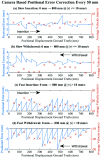A Real-Time Endoscope Motion Tracker
- PMID: 36457895
- PMCID: PMC9704742
- DOI: 10.1109/JTEHM.2022.3214148
A Real-Time Endoscope Motion Tracker
Abstract
Objective: In colonoscopy, it is desirable to accurately localize the position of the endoscope's distal tip. Current tip localization techniques are not sufficient for recording the position and movement of the tip, nor is its rotation measured. We hypothesize that integration of multiple tracking modalities can effectively record the endoscope's motion in real time and continuously corrects cumulative errors.
Methods: A dual modality tracking method is developed to measure the motion of the endoscope's insertion tube in real time, including insertion length, rotation angle, and their velocities. Optical trackballs were used to measure the endoscope insertion tube's motion and cameras were used to correct cumulative errors.
Results: The accuracy of insertion length and rotational angle were measured. For speeds ≤ 10 mm/s, the median and 90th percentile insertion position errors were 0.88 mm and 2.2 mm, respectively. The insertion position error increases with the speed, reaching a maximum of 10 mm for speeds < 40 mm/s. 11° and 21° were the median and 90th percentile rotation angle errors for angular speeds < 40°/s. Cumulative errors are sufficiently reduced by the imaging modality.
Conclusion: The prototype device can precisely measure an unmodified endoscope's position, rotation, and motion in real time without significant accumulative error. The prototype device is small and compatible with existing commercial endoscopes as an add-on accessory, which could be used for reporting, localizing the lesions in follow up procedures, operational guidance, quality assurance, and training. Clinical and Translational Impact Statement-This preclinical research develops an endoscope tracker that can be integrated into colonoscopy training, automatically record endoscope motion, and be further developed to improve polyp and tumor localization during colonoscopy.
Keywords: Colonoscopy; endoscopes; medical devices; motion measurement; real-time systems.
Figures







References
-
- Cancer Care Ontario. (Apr. 18, 2022). Screening for Colorectal Cancer. Accessed: Oct. 14, 2022. [Online]. Available: https://www.cancercareontario.ca/en/types-of-cancer/colorectal/screening
Publication types
MeSH terms
LinkOut - more resources
Full Text Sources
Other Literature Sources

